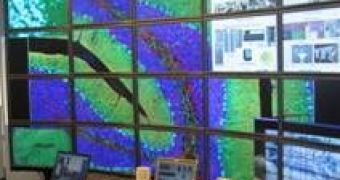The Scalable Adaptive Graphical Environment for Windows is not a Microsoft project per se. SAGE was developed by the National Center for Microscopy and Imaging Research, but this does not mean that the Redmond company is a stranger to the project. In fact, NCMIR acknowledged support from Microsoft, namely the Research and Development division for creating SAGE. The Scalable Adaptive Graphical Environment enables large tiled displays to be set up via computers running 32-bit editions of the Windows operating system.
"SAGE is a graphics streaming architecture, originally developed by the Electronic Visualization Laboratory at the University of Illinois at Chicago, for supporting high-resolution, scalable and collaborative scientific visualization environments. It is primarily designed to be run as a thin middleware on a high bandwidth-enabled, cluster-driven tile display", revealed Dan Fay, Director, Technical Computing North America, citing the description of SAGE.
The Scalable Adaptive Graphical Environment software is designed to provide support for contiguous display resolutions in terms of hundreds of megapixels, when it comes down to creating the necessary infrastructure but also to configuring scalable tile displays. However the tile displays do not come cheap. According to the data provided by NCMIR, a display of just 20 Megapixels will cost an estimated $68,000 while one with 27 Megapixels will come with a price tag of $74,000.
"It allows users to treat the high-resolution distributed displays as one contiguous desktop where users can move/resize application windows. SAGE is network centric and the applications running on these displays need not run locally. The applications can be run on remote machines or clusters, and they can stream their pixel frame buffers to SAGE-enabled tile displays", Fay added.
The Scalable Adaptive Graphical Environment for 32-bit Windows is available for download here.

 14 DAY TRIAL //
14 DAY TRIAL //